EGFIE LLC
We always add value to our customers
Search by Keyword
Product Categories
Small interfering RNA (siRNA), sometimes known as short interfering RNA or silencing RNA, has a well-defined structure: a short (usually 21-nt) double strand of RNA (dsRNA) with 2-nt 3' overhangs on either end. siRNAs can be introduced into cells by various transfection methods to bring about the specific knockdown of a gene of interest. Essentially any gene of which the sequence is known can thus be targeted based on sequence complementarity with an appropriately tailored siRNA. This has made siRNAs an important and indispensable tool for gene function and drug target validation studies in the post-genomic era.
While liposome or polymer reagents often give very good DNA delivery efficacy, they often failed to efficiently drive siRNA into mammalian cells due to the length of the siRNA anionic segment that is too short to maintain electrostatic cohesion with the cationic lipids or polycationic polymer. We modified the liposome and polymer by addition of specific pre-screened hydrophobic groups which confers the pH dependent conformational changes (PDCC) at physiological pH condition and greatly stabilizes siRNA lipolplex or polyplex.
Based on our unique and proprietary “PDCC” technology, currently we are developing and manufacturing the following four siRNA transfection reagents, which show distinct transfection characteristics with the leading products in the market.
siRNA Transfection Reagent Selection Chart.
| Reagents | Features | Transfection Type | Toxicity |
| - PepMute™ | - Exceptional good for siRNA transfection - OK for DNA/siRNA co-transfection |
siRNA DNA/siRNA |
++ |
| - GenMute™ | - Exceptional good for siRNA transfection - Excellent for DNA/siRNA co-transfection |
siRNA DNA/siRNA |
++ |
| - PowerFect™ | - OK for siRNA transfection - Excellent for DNA transfection - Excellent for DNA/siRNA co-transfection |
DNA DNA/siRNA |
+ |
| - PepMute™ Plus | - Exceptional good for siRNA transfection - Excellent for DNA/siRNA co-transfection |
siRNA DNA/siRNA |
++ |
Description:
PepMute™ siRNA Transfection Reagent, formulated from simulation of virus cell penetrating peptides (CPPs), is a total novel siRNA delivery tool which provides more than 95% silencing efficiency at 1 nM siRNA in variety of mammalian cells. With our proprietary peptide simulation technology (PST), hundreds of viral CPPs were simulated, synthesized and screened for gene delivery efficacy in variety of mammalian cells (Figure 1). PepMute™ reagent was then identified and validated as an exceptionally efficient vector for condensing and transfecting short (under 100 bp) single or double stranded nucleic acids such as siRNA, miRNA mimics and DNA oligoes to wide spectrum of mammalian cells.
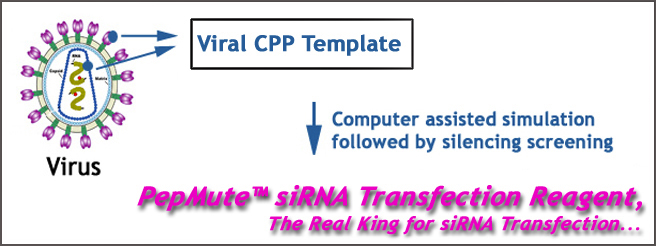
Figure 1. A cartoon showing PepMute™ siRNA Transfection Reagent was developed by PST
Size:
- PepMute™ Reagent, 1.0 ml, sufficient for ~1,333 reactions based on transfecting 0.5~5.0 pmol siRNA or miRNA mimics in 24-well plate
- PepMute™ Transfection Buffer (5x ), formulated for maximal transfection efficiency, 8.0 ml at 5x concentrated stock solution to make 40 ml of working solution
Applications:
- siRNA miRNA mimics or mRNA transfection
- DNA/siRNA co-transfection
- DNA oligoes transfection
Storage:
Store at 4 °C and never freeze. If stored properly, the product is stable for 12 months or longer.
Advantages:
- Excellent silencing at final 1.0 nM siRNA
- Over 95% gene silencing in a wide variety of cells
- One tube reaction with easy standard protocol
- Compatible with serum and antibiotics
- Protocols adapted to HTS
- Very low cytotoxicity
- Very affordable
Silencing Efficacy Comparison between PepMute™ siRNA Transfection Reagent and Leading Products
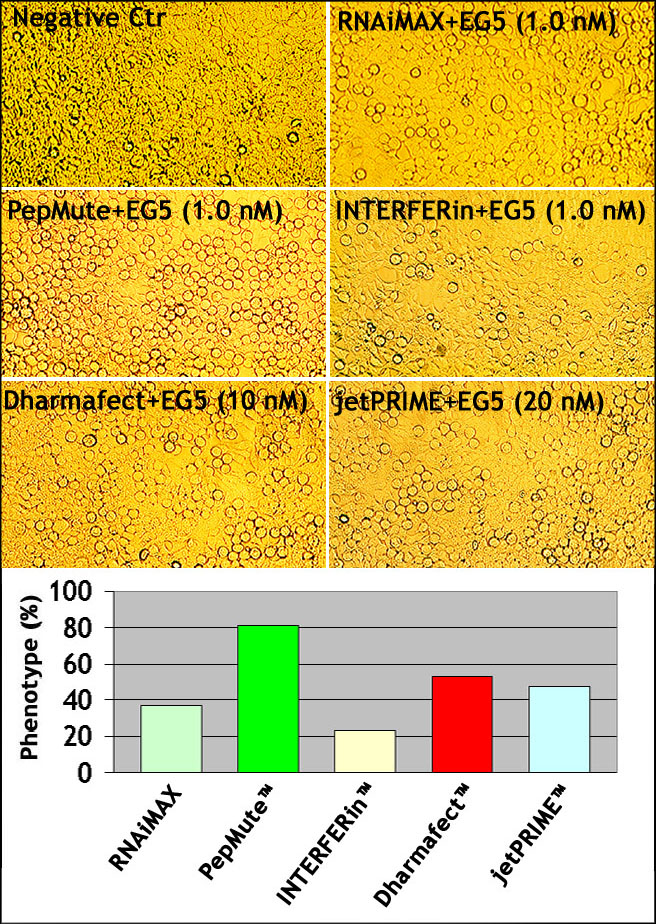
Figure 2. Excellent silencing of endogenously expressed KIF11 (also known as EG5) in HEK293 cells with 1.0 µl of PepMute™ reagent and 0.5 pmol EG5 siRNA per well of 24-well plate. KIF11 (also known as EG5) encodes a motor protein that belongs to the kinesin-like protein family involved in chromosome positioning and bipolar spindle formation during cell mitosis. A reduction in KIF11 levels causes mitotic arrest. PepMute™ reagent effectively delivers EG5 siRNA (final 1.0 nM) to HEK293 cells, leading to more than 80% of "round-up" phenotype of HEK293 cells 48h post transfection over negative control (final 1.0 nM with sham EG5 siRNA) while leading siRNA transfectin reagents, Lipofectamine™ RNAiMAX (RNAiMAX, 1.0 nM EG5 siRNA) / INTERFERin (1.0 nM EG5 siRNA) / Dharmafect (10.0 nM EG5 siRNA) and jetPRIME (20 nM EG5 siRNA) give average 37%, 23%, 53% and 48% ball-shaped phenotype respectively on HEK293 cells. The phenotype of "rounded-up" 293 cells were visualized (upper panel) and quantified (lower panel) 48h post transfection with a Nikon microscope.
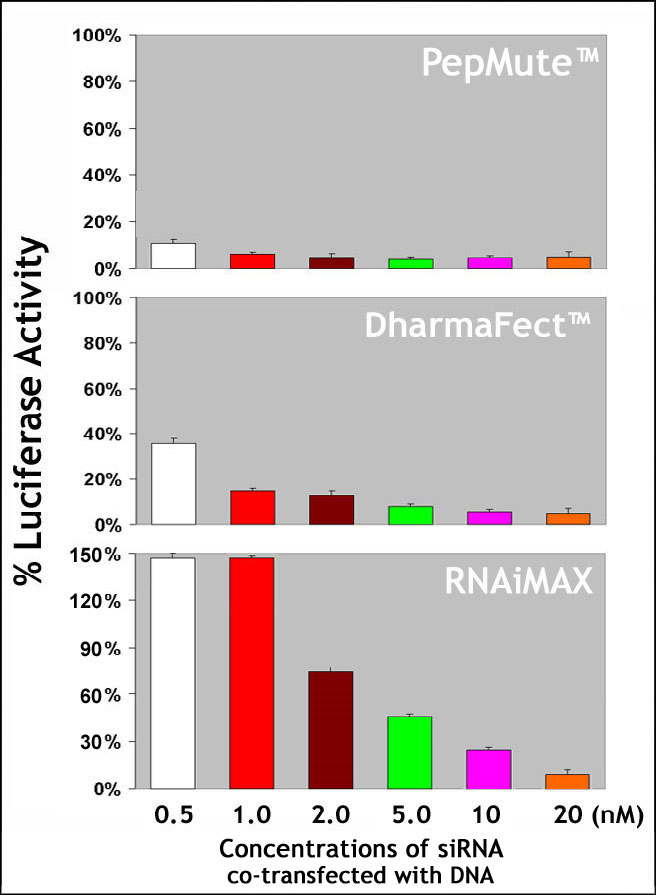
Figure 3. Silencing efficiency comparison of PepMute™ Transfection Reagent (upper panel) with Dharmafect 4 (middle panel) and Lipofectamine™ RNAiMAX (RNAiMAX, lower panel) siRNA Transfection Reagents on A549 cells.siRNA targeting renilla luciferase at different final concentrations ranging from 0.5 to 20 nM was co-transfected with renilla luciferase gene (0.5 µg of pRL-CMV DNA per well) by the above three transfection reagents per manufacturers' protocols into A549 cells growing on a 24-well plate. Renilla luciferase activity was determined 36h after post co-transfection with renilla luciferase determination system (Promega). The luminescence was measured from 5.0 µl of lysate during 10s integration with a luminometer (Beckman Coulter LD 400). Luciferase activity was expressed as light units integrated over 10s (RLU) and normalized per mg of cell protein by using the BCA assay. The errors bars represent standard deviation derived from triplicate experiments. Luciferase-silencing efficiency was calculated relative to untreated cells. While PepMute™ and Dharmafect™ 4 reagents delivered significant gene silencing from 1.0 nM of renilla luciferase siRNA, Lipofectamine™ RNAiMAX gave good knockdown only after 20 nM while enhanced gene expression at low concentration of siRNA (0.5 and 1.0 nM respectively) was observed.
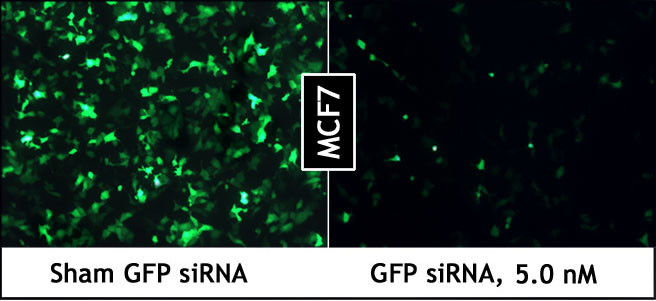
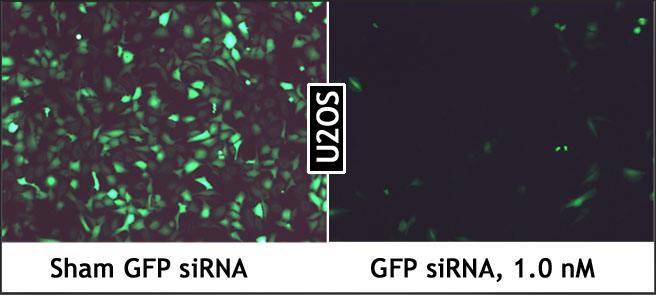
Figure 4. PepMute™ Transfection Reagent knocked down stable GFP expression in MCF7 cell (upper panel) and U2OS cell (lower panel) by reversely transfecting 5.0 and 1.0 nM GFP siRNA respectively. Green fluorescence protein (GFP) was stably expressed in MCF7 and U2OS cells. siRNA targeting GFP gene (right panel) and a sham siRNA (left panel) were introduced into MCF7 and U2OS cells with final 5.0 and 1.0 nM respectively by reverse transfection with PepMute™ Transfection Reagent. GFP gene silencing was monitored 48h post transfection by a Nikon fluorescence microscope. Quantitative analysis showed that GFP siRNA at 5.0 and 1.0 nM delivered by PepMute™ siRNA Transfection Reagent knocked down 90% and 95% stably expressed GFP in MCF7 and U2OS cells respectively.
Data Sheet & Protocol
- A Standard siRNA Transfection Protocol ![]()
- A Standard siRNA/DNA Co-transfection Protocol ![]()
- A Reverse siRNA Transfection Protocol for HTS ![]()
Testimonials:
I had tried your product pepMute transfection reagent on primary retinal neurons and was satisfied with the transfection efficiency. Will order!
- Vijai Krishnan Ph.D, Louisiana State University
I really appreciate you sending me a sample of PepMute siRNA reagent. I tested DNA/siRNA co-transfection using 293T cells and the results were completely satisfactory. I was able to get 95% knockdown of my target gene at 1.0 nM siRNA as well as expression of plasmid DNA using the recommended protocol. I will have to test and see if other cell lines are also as effective. I will definitely think about moving to use this reagent over Dharmafect or Oligofectamine.
- HARISH N. RAMANATHAN Ph.D., NIDDK, NIH
I tried PepMute reagent and I like it. It has so high efficiency and no cytotoxicity. I am going to use it. Thank for introducing it to our lab.
- Radmila Hrdlickova, Ph.D., UT Austin
Tried 3 different siRNAs with 100% silencing on A2780 cell. That is amazing! I already placed an order.
- Doris Benbrook, Ph.D., OUHSC
Yes, I certainly did use that sample of PepMute you generously sent us… and it worked so well on HepG2 cells that I have since ordered a full size and am using it exclusively for siRNA! I compared to RNAiMAX and Roche’s X-tremeGENE products, but these products were not as effective as PepMute. Thanks again for the sample. It was fantastic!
- Matthew Jackson, Ph.D., USDA
Shopping Basket
| Items: | 0 |
| Subtotal: | $0.00 |
customer@egfie.com